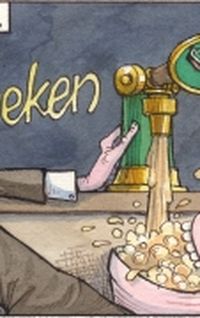Innovating to stay on top: In another year of challenges, including negative rates and drastic changes in regulations and markets, Credit Suisse held its head high, providing innovative answers and maintaining its lead in the face of stiffening competition. For its solid performance and novel solutions, the firm is IFR’s Swiss Franc Bond House of the Year.
To see the full digital edition of the IFR Review of the Year, please <a href="http://edition.pagesuite-professional.co.uk//launch.aspx?eid=24f9e7f4-9d79-4e69-a475-1a3b43fb8580" onclick="window.open(this.href);return false;" onkeypress="window.open(this.href);return false;">click here</a>.
With a seemingly perennial hunt for yield as prevailing rates dropped to all-time lows, the Swiss franc market saw multiple innovations in 2012, with more than half of the deals led or jointly led by Credit Suisse. Out of 358 Swiss franc deals and taps in the awards period, Credit Suisse was present on 189, according to IFR figures – a 53% hit rate.
As the landscape shifted, some old stalwarts of the market almost ceased issuing, while interesting newcomers emerged.
Ultra-low rates and tighter bank regulation led directly to two asset classes taking off – hybrids and mid-cap corporates.
Tighter regulation required banks and financial institutions to boost their capital buffers and hence brought in the need for the issuance of hybrids and contingent capital, a sector Credit Suisse pioneered with its groundbreaking CoCos totalling SFr700m (US$750m).
The Swiss regulator’s proactive stance on capital-raising far ahead of Basel III has provided a strong impetus for financial firms to issue. As well as self-led CoCos, the bank was also joint lead on Bank Julius Baer’s innovative Tier 1 offering.
It was also instrumental in the new structure behind Swiss Re’s SFr320m 7.25% perpetual non-call 5.5-year hybrid deal, which took more than six months to put together, as well as Swiss Life’s more traditional SFr300m perpetual non-call 5.8-year 5.5% hybrid.
“We were at the forefront of these developments, leveraging on our superior relationship with the issuers, our structuring expertise to deliver tailor-made instruments to each of these issuers and our ability to distribute these novel products to the traditional Swiss franc investor base,” said Dominique Kunz, managing director of capital markets at Credit Suisse in Zurich.
Tighter regulations also cut the amount that banks would or could comfortably lend to corporates. Those firms soon found that the capital markets were a viable alternative to bank lending in terms of pricing. Investors also welcomed the opportunity to diversify their investments into new names.
Credit Suisse capitalised on this trend, leading a multitude of new smaller corporates. The list included Meyer Burger and OC Oerlikon’s debut transactions, as well as crossover credit Clariant’s SFr285m 3.25% April 2019 seven-year as investors’ appetite for yield outweighed their fear of lower credits.
In the high-grade corporate arena, Credit Suisse joint led the largest deal of the year, Roche’s SFr1.5bn triple-trancher.
FATCA fightback
US corporates looked set to be regulated out of the market when American Foreign Account Tax Compliant Act rules took effect in February. It seemed that US truck maker Paccar may be the last American issuer able to come to the Swiss market, slipping in just before the implementation.
But never one to let the seemingly impossible stop it, the bank fought back.
After more than two years of painstaking work with lawyers and officials, it devised a structure that satisfied both Swiss and US regulators. In August, that was put to the test when Philip Morris came with a SFr200m eight-year deal, the first FATCA-compliant issue in the Swiss market. It was followed in mid-November with a debut SFr250m six-year from Goldman Sachs, joint led by Credit Suisse and Goldman Sachs.
Highly rated issuers were distinctly lacking, if not absent, for most of 2012, a large and volatile basis swap keeping many at bay. The extremely low prevailing rates meant that any bonds that required swapping back into their native or preferred currency, usually euros or US dollars, were not only hit with an unfavourable basis swap out of the franc, but also with an expensive zero percent floor to avoid negative rates.
Replacing much of the absent high-grade SSA paper in 2012 was a resurgence in canton and municipal trades, many of which had not been seen for more than five years.
Credit Suisse was instrumental in Zurich’s bumper SFr1bn triple-trancher in early November, as well as Geneva’s SFr500m triple-trancher in September and Solothurn’s SFr300m dual-tranche. It was also sole lead on the Canton Geneva SFr175m 20-year and the City of Lugano SFr100m 10-year.
In the covered bond sector, the lack of mainland European supply, either due to tight spreads or worrying markets, saw a surge in Antipodean issuance after covered bond laws were passed in Australia and New Zealand. More than SFr2.5bn of this new asset class was priced by the end of September.
Credit Suisse spearheaded this part of the market, with the debut ANZ and ANZ National covered deals in January, as well as participating in the ASB, CBA and Westpac transactions that followed.
Emerging emerges
Emerging market names were an obvious go-to for yield-hungry buyers. In 2008, emerging market regions accounted for just 4% of international issuance in Swiss francs. By 2012, this had risen to a 20% market share.
There were the perennial favourites from Eastern Europe, Latin America and South Korea, where Credit Suisse was involved in most of the major trades. Russia’s VTB Bank SFr600m 3.15% long four-year LPN maturing in December 2016 stood out for its huge size. It was the largest Russian single-tranche deal ever in the Swiss market.
Credit Suisse also led more Indian issuance from REC, as well as new names from new countries like Israeli pharmaceutical Teva, Black Sea Trade and Development Bank, Lithuania and African Bank from South Africa.
“The trend toward increased emerging market issuance in Swiss francs is expected to continue, and we have acquired unparalleled expertise that should allow us to maintain this leadership,” said Kunz.
The other higher-yielding foreign alternative, peripherals, had a bit of a roller-coaster year. Enel reopened the Italian sector in September with a dual-tranche SFr480m deal in six and 15 years, coming some 15bp–20bp inside comparable euro-denominated financings. Credit Suisse was on that, as well as the follow-up trade in October (as sole lead). The bank also jointly led the first peripheral of the year – Spanish Iberdrola’s SFr250m 3% five-year – as well as EDP’s SFr125m 4% six-year in November.
Asset-backed back
Of special note has to be the revival of the asset-backed market.
During the financial crisis, the product was no longer deemed viable in the context of the Swiss franc bond market.
Reopening this segment, even with a domestic market issue, was therefore a challenge deemed insurmountable by most lead managers. But it was another opportunity for the bank to illustrate its superior grasp of this market.
It established a domestic public ABS segment in francs, acting as sole lead manager and sole structuring agent on the two pioneering deals issued in 2012, after more than a year of complex structuring work.
It brought a SFr200m car lease-backed transaction for Swiss Auto Lease, backed by assets originated by GE Money Bank Switzerland. This was followed by a SFr370m credit card receivables-backed transaction for Swiss Credit Card with assets originated by Swisscard.
Truth in numbers
With a market share of 33% in the international segment for the first three quarters of 2012, Credit Suisse defended its top-of-the-table position for the 22nd year running.
Although strenuous efforts by competitors pulled it back a bit to a final 31.6% share of the international segment, the firm maintained a clear 4% lead over its nearest rival, UBS.
In the domestic segment, Credit Suisse was also the clear winner, with a 35% market share. The firm takes the award for the third year running, having received it nine times this millennium.
“We redefined the spectrum of the Swiss franc bond market, establishing new asset classes to replace diminishing ones, bringing new issuers that were previously deemed unviable for this market and, in doing so, overcoming challenges thought insurmountable,” said Kunz.



